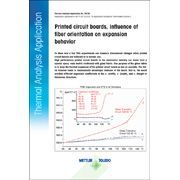Printed Circuit Boards, Influence of Fiber Orientation on Expansion Behavior
 To show how a few TMA experiments can measure dimensional changes when printed circuit boards are soldered or in normal use.
To show how a few TMA experiments can measure dimensional changes when printed circuit boards are soldered or in normal use.
High performance printed circuit boards in the electronics industry are made from a special epoxy resin matrix reinforced with glass fabric. One purpose of the glass fabric is to keep the thermal expansion of the printed circuit board as low as possible. The fabric however leads to mechanically anisotropic behavior of the board, that is, the board exhibits different expansion coefficients in the x- (width), y- (depth), and z- (height or thickness) directions.
| Handbook | | Page | | Keywords |
| Thermosets 2 | 75 | thermoset, curing, TMA, expansion coefficient, glass fibers, PCB, |
Printed Circuit Boards, Influence of Fiber Orientation on Expansion Behavior | Thermal Analysis Application No. HB 55 | Application published in METTLER TOLEDO TA Application Handbook Thermosets Volume 2